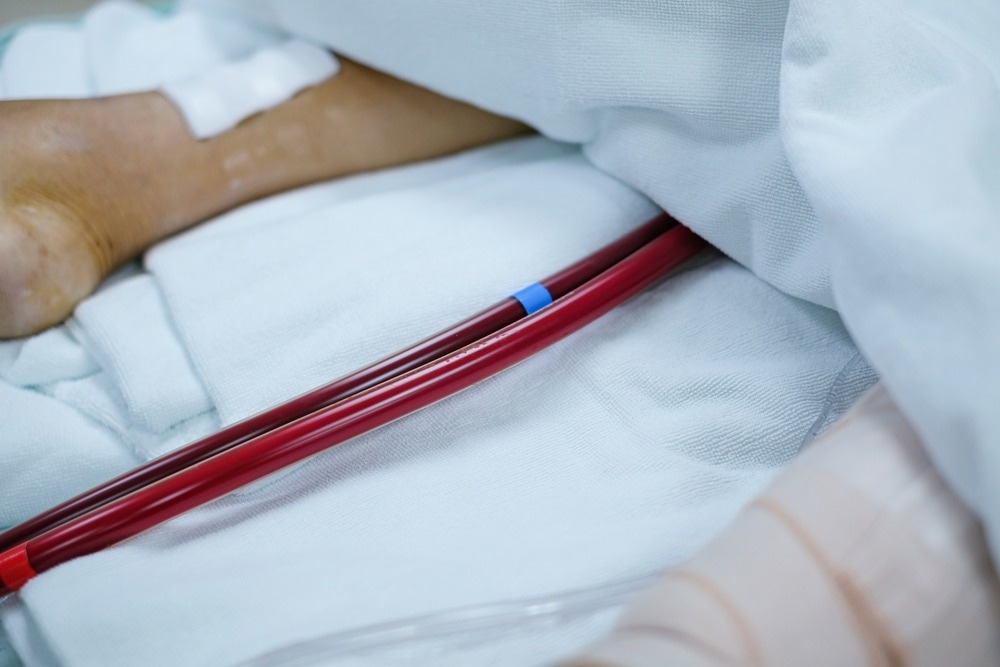In a recent study published in ASAIO Journal, researchers comparatively assessed mortality rates among CARDS [coronavirus disease 2019 (COVID-19) acute respiratory distress syndrome] patients on ECMO (extracorporeal membrane oxygenation) infected with severe acute respiratory syndrome coronavirus 2 (SARS-CoV-2) variants of concern (VOCs) during the first wave (W1), the second wave (W2) and the third wave (W3) of COVID-19.
 Study: Mortality of COVID-19 Patients Requiring Extracorporeal Membrane Oxygenation During the Three Epidemic Waves. Image Credit: PIJITRA PHOMKHAM/Shutterstock
Study: Mortality of COVID-19 Patients Requiring Extracorporeal Membrane Oxygenation During the Three Epidemic Waves. Image Credit: PIJITRA PHOMKHAM/Shutterstock
Background
From February 2020 onwards, several COVID-19 waves occurred in France, and the clinical presentations and mortality rates of ECMO-treated CARDS patients differed during each pandemic wave. COVID-19 management evolved with increased knowledge of SARS-CoV-2 VOC infections. However, data on ECMO outcomes among individuals infected with SARS-CoV-2 VOCs are limited.
Despite early corticosteroid administration, mechanical ventilation use, systemic medications for anticoagulation, and experience of the first pandemic wave, patient mortality was unaltered for ICU (intensive care unit)-admitted patients and even increased among those with mechanical ventilation requirements. During W2, studies reported higher mortality, ECMO duration, WF (weaning failures), and ECMO duration. Despite enormous vaccination coverage for high-risk individuals by January 2021, France faces a third pandemic wave from March 2021 onwards.
During the initial pandemic wave, several CARDS patients required ECMO in the Amiens University Hospital center, and >50% of patients survived. During W3, to increase patient survival rates and avoid CARDS cases not requiring ECMO [based on the ECMO to Rescue Lung Injury in Severe ARDS (EOLIA) criteria], the team included the COVID-19 progression duration (i.e., the duration between symptom onset and ECMO) in the ECMO implantation criteria, based on clinical experience gained in the first and second waves.
About the study
In the present study, researchers compared mortality rates among ECMO-treated CARDS patients during W1, W2, and W3 in France, as an ancillary study of a prospective cohort study of ICU-admitted COVID-19 patients conducted at Amiens University tertiary care hospital.
Fifty-four CTVR-ICU (cardiac thoracic vascular and respiratory ICU)-admitted severe CARDS patients with ECMO requirements during W1 (between 28 February 2020 and 1 June 2020), W2 (between 1 September 2020 and 15 April 2020) and W3 (between 12 December 2020 and 15 June 2021). Pre-ECMO risk factors estimating 90-day mortality rates were assessed using multivariate Cox regression modeling.
The team excluded participants who died during ECMO, had veno-arterial type ECMO before veno-venous type ECMO or had ECMO for major thoracic surgeries. Data on patient sex, age, comorbidities, BMI (body mass index), medical test reports, dates of symptom onset, admission to the ICU, intubations, and ECMO treatment initiation were obtained prospectively. SOFA (sepsis-related organ failure assessment) scores and RESP (respiratory ECMO survival prediction) scores were used to measure CARDS severity and estimate patient survival, respectively.
Before ECMO treatment, the team reviewed computed tomography (CT) scans, laboratory test reports, ventilator settings, plateau pressure, respiratory rate, driving pressure, tidal volume, oxygen and carbon dioxide levels in arteries, rescue therapy (nitric oxide inhalation and prone positioning) and SARS-CoV-2-targeted therapies. The prime study outcome was in-hospital deaths assessed on day 90 post-ECMO initiation.
Results
In total, 217 CARDS patients were enrolled between 28 February 2020 and 15 June 2021, of which 64, 36, and 117 patients were infected during W1, W2, and W3, respectively. Of 217 patients, 61 received ECMO, of which seven were excluded, and as a result, 54 patients were followed up for 90-day mortality, of which 14, 14, and 26 were infected during W1, W2, and W3, respectively.
Fourteen, 14, and 26 CARDS patients required ECMO during W1, W2, and W3, respectively. The median age of the participants was 61 years, and 75% were males with a median SOFA score of 11. There were no statistically significant differences during the three waves except for greater serological creatinine levels among patients infected during W1. The duration between symptom onset to ECMO (17 days versus 11 days) and from ICU admission to intubation (four days versus one day) was greater during W2 than W1.
In addition, ECMO support duration (24 days versus 10 days), ICU stay (36 days versus 26 days), and mechanical ventilation (37 days vs. 25 days) were higher, and survival was lower during W2. The 90-day death rates were greater in W2 (85% versus 43%) but lesser in W3 (38% versus 85%). Pre-ECMO ventilation settings differed for W2 patients; median values for static compliance and driving pressures were 20 cm H2O versus 30 cm H2O, and 17 versus 14, respectively.
Glucocorticoids were administered mostly after W1, and femoral-jugular cannulas were inserted in 95% of patients three days post-intubation. During their ICU stay, all W2 and W3 patients developed ventilator-associated pneumonia. Over 59% (n=32) of patients were weaned from ECMO, and 28 patients died. The 90-day mortality rate significantly elevated from W1 to W2 (six versus 12 patients) and significantly decreased from W2 to W3 (12 versus 10 patients). RESP scores and time from symptoms onset to ECMO (hazard ratio of 1.1) were independent mortality factors.
Conclusion
To summarize, the 90-day mortality rates increased during W2 but improved during W3, and COVID-19 progression before ECMO could be an independent factor associated with 90-day mortality. CARDS prognosis worsened 12 after disease evolution, making ECMO therapy ineffective for such patients.